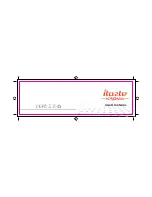
12
1.
Based on the volume, calculate the amount of paraformaldehyde and ammonium bicarbonate
needed as follows:
o
Paraformaldehyde amount (gram): Total volume (m3) x 11gram/m3
o
Ammonium bicarbonate amount (gram):
Steps to determine the amount of Ammonium Bicarbonate required:
a.
Determine the stoichiometric amount of ammonium bicarbonate needed to produce the
requisite amount of ammonia gas that would neutralize the resulting formaldehyde gas.
b.
To ensure completion of the reaction, make sure that the weight of ammonium bicarbonate
is 10% greater than the weight of the paraformaldehyde used.
2.
Typically, formaldehyde is non-penetrative. So the Unit does not have to be pressure tight.
Completely seal the Unit and ensure air-tightness inside the enclosure by using tapes at all
appropriate places. Pay special attention to the power supply cables.
3.
Wear appropriate protective clothing.
4.
Spread the paraformaldehyde evenly over the surface of the heating device. Set the thermostat to
232°C to 246°C (450°F to 475°F).
5.
Another heating device is placed on the work tray for the ammonium bicarbonate. At this stage, the
ammonium bicarbonate should be restricted from mixing with the air in the Unit.
Following are two ways of restricting Ammonium Bicarbonate:
Method 1:
1.
Spread the ammonium bicarbonate evenly over the surface of the heating device and then cover the
device with aluminum foil in such a way that ammonium bicarbonate cannot react with formaldehyde
while decontamination is in progress.
2.
The aluminum foil can be placed in such a way that it allows ammonia gas to escape when the device
is heated. Alternatively, some provision can be made for removing the aluminum foil remotely at the
beginning of the neutralization phase.
3.
Make sure that the deployment of such a removal mechanism doesn’t lead to unsafe levels of
formaldehyde escaping out of the decontamination bag enclosing the Unit.
Method 2:
Seal the Unit using a special plastic sheet that has a pair of gloves built into it. The ammonium bicarbonate is
placed in a sealed container inside the Unit.
Using the built-in gloves, the person performing the decontamination would be able to reach the work zone of
the Unit without having to break the seal. At the beginning of the neutralization phase, ammonium
bicarbonate is removed from the sealed container and spread evenly over the surface of the heating device.
The heating device is then switched on so that ammonia is generated from ammonium bicarbonate.
1.
After approximately 25, 50, 75, and 100% of the formalin being evaporated, turn on the Unit blower
for 10 to 15 seconds to circulate the formalin throughout the unit.
2.
In cases where Unit blower is inoperative, circulation of air inside the Unit should be promoted with
additional blower or fans, or the time of decontamination should be extended beyond the times
suggested below.
3.
Allow the formalin vapor a minimum 6 hours (10 to 12 hours is preferable) contact time inside the
unit.
4.
Once the formalin decontamination time is reached, start the apparatus containing 25% ammonium
bicarbonate to neutralize the paraformaldehyde. It is recommended to circulate the ammonia by
turning on the Unit blower at the same interval as the formalin vaporization. Without any circulation,
the neutralization time should be extended to a minimum of 6 hours.
5.
Let the ammonia vapor to have a contact time of at least 1 hour (2 hours is preferable) after the
solution has been completely evaporated, before opening the seals. Please be aware that the
formaldehyde and/or ammonia concentration inside the decontamination bag may be above the STEL
and full face mask with formalin filter is required when opening the decontamination bag.
Summary of Contents for FV-001
Page 4: ...ii ...
Page 8: ...vi ...
Page 10: ...viii ...
Page 16: ...6 ...
Page 24: ...14 ...
Page 25: ...APPENDIX ...
Page 26: ......
Page 28: ......































